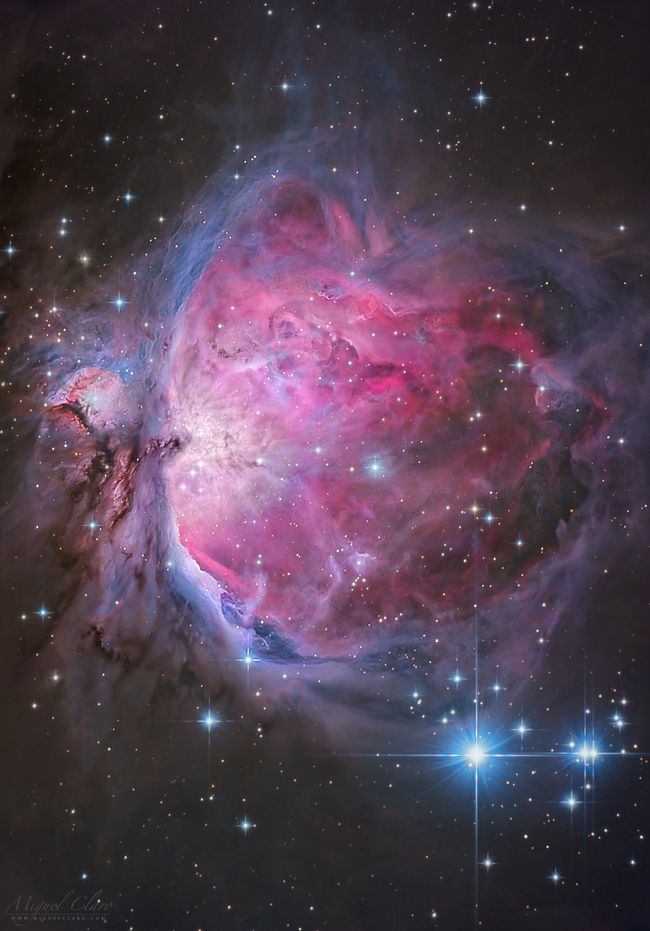Welcome to DU!
The truly grassroots left-of-center political community where regular people, not algorithms, drive the discussions and set the standards.
Join the community:
Create a free account
Support DU (and get rid of ads!):
Become a Star Member
Latest Breaking News
General Discussion
The DU Lounge
All Forums
Issue Forums
Culture Forums
Alliance Forums
Region Forums
Support Forums
Help & Search
Science
Related: About this forumGorgeous Orion Nebula Glows in Stunning Red and Blue Light (Photo)
By Miguel Claro 18 hours ago Science & Astronomy
Deep-space nebula, or cosmic cotton candy?

(Image: © Miguel Claro)
Miguel Claro is a professional photographer, author and science communicator based in Lisbon, Portugal, who creates spectacular images of the night sky. As a European Southern Observatory photo ambassador, a member of The World At Night and the official astrophotographer of the Dark Sky Alqueva Reserve, he specializes in astronomical "Skyscapes" that connect Earth and the night sky. Join Miguel here as he takes us through his photograph "The Great Orion Nebula: A Colorful Show in Visible Light."
Captured in the visible light spectrum, this deep-space image paints a sharp and colorful picture of the great Orion Nebula.
Also known as Messier 42 (M42), the Orion Nebula spans about 24 light-years across and is part of the much larger Orion Molecular Cloud Complex. The nebula is situated in the Milky Way some 1,350 light-years away from Earth in the constellation of Orion, the hunter, and it can be seen with the naked eye south of Orion's belt.
Colorful clouds of cosmic dust and gas that make up the Orion Nebula fuel the formation of new stars. This stellar nursery is "the closest large star-forming region to Earth," which is why the nebula has "a relatively bright apparent magnitude of 4," according to NASA.
The brightest central part of the nebula is called the "Huygenian region" (named after the 17th-century astronomer Christiaan Huygens). To its left is a dark nebulosity nicknamed the "Fish's Mouth," which separates M43 — another smaller nebula adjacent to M42 on the left side of this image — from the brighter region of M42. Along the outside edges of the cloud formation, we can also find the so-called "wings" of Orion. Shining at the heart of the Orion Nebula is the Trapezium star cluster, named after the four bright stars it contains
More:
https://www.space.com/orion-nebula-visible-light-photo-miguel-claro.html
InfoView thread info, including edit history
TrashPut this thread in your Trash Can (My DU » Trash Can)
BookmarkAdd this thread to your Bookmarks (My DU » Bookmarks)
3 replies, 1201 views
ShareGet links to this post and/or share on social media
AlertAlert this post for a rule violation
PowersThere are no powers you can use on this post
EditCannot edit other people's posts
ReplyReply to this post
EditCannot edit other people's posts
Rec (13)
ReplyReply to this post
3 replies
 = new reply since forum marked as read
Highlight:
NoneDon't highlight anything
5 newestHighlight 5 most recent replies
= new reply since forum marked as read
Highlight:
NoneDon't highlight anything
5 newestHighlight 5 most recent replies
Gorgeous Orion Nebula Glows in Stunning Red and Blue Light (Photo) (Original Post)
Judi Lynn
May 2019
OP
2naSalit
(86,636 posts)1. Sort of looks like
a giant peony about ready to open. Very cool!
GetRidOfThem
(869 posts)2. thank you for posting this
As an amateur astronomer myself, I really appreciate visible spectrum photography. This is not just scientific imaging, but could becseen as a work of art.
eppur_se_muova
(36,263 posts)3. This is one of the easiest objects to spot in the night sky ...
it's dimly visible to the naked eye as a green glow, and appears as such in binoculars.
Back in my teens, I photographed it with a 35mm camera (film) and telephoto lens, opening the shutter for several seconds without tracking. Not much of a photo, but the nebula did register on color film !
https://earthsky.org/clusters-nebulae-galaxies/orion-nebula-jewel-in-orions-sword
Longer exposures show more and more structure of the nebula, and more and more stars within the cloud.
The Nebula is part of a much larger nebula that is known as the Orion Molecular Cloud Complex. The Orion Molecular Cloud Complex extends throughout the constellation of Orion and includes Barnard's Loop, the Horsehead Nebula, M43, M78, and the Flame Nebula. Stars are forming throughout the entire Cloud Complex, but most of the young stars are concentrated in dense clusters like the one illuminating the Orion Nebula.[31] [32]
https://en.wikipedia.org/wiki/Orion_Nebula
https://en.wikipedia.org/wiki/Orion_Nebula